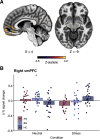Prefrontal Responses during Proactive and Reactive Inhibition Are Differentially Impacted by Stress in Anorexia and Bulimia Nervosa
- PMID: 33846229
- PMCID: PMC8152613
- DOI: 10.1523/JNEUROSCI.2853-20.2021
Prefrontal Responses during Proactive and Reactive Inhibition Are Differentially Impacted by Stress in Anorexia and Bulimia Nervosa
Abstract
Binge eating is a distressing, transdiagnostic eating disorder symptom associated with impulsivity, particularly in negative mood states. Neuroimaging studies of bulimia nervosa (BN) report reduced activity in frontostriatal regions implicated in self-regulatory control, and an influential theory posits that binge eating results from self-regulation failures under stress. However, there is no direct evidence that psychological stress impairs self-regulation in binge-eating disorders, or that any such self-regulatory deficits generalize to binge eating in underweight individuals (i.e., anorexia nervosa bingeing/purging subtype; AN-BP). We therefore determined the effect of acute stress on inhibitory control in 85 women (BN, 33 women; AN-BP, 22 women; 30 control participants). Participants underwent repeated functional MRI scanning during performance of the Stop-signal anticipation task, a validated measure of proactive (i.e., anticipation of stopping) and reactive (outright stopping) inhibition. Neural and behavioral responses to induced stress and a control task were evaluated on 2 consecutive days. Women with BN had reduced proactive inhibition, while prefrontal responses were increased in both AN-BP and BN. Reactive inhibition was neurally and behaviorally intact in both diagnostic groups. Both AN-BP and BN groups showed distinct stress-induced changes in inferior and superior frontal activity during both proactive and reactive inhibition. However, task performance was unaffected by stress. These results offer novel evidence of reduced proactive inhibition in BN, yet inhibitory control deficits did not generalize to AN-BP. Our findings identify intriguing alterations of stress responses and inhibitory function associated with binge eating, but they counsel against stress-induced failures of inhibitory control as a comprehensive explanation for loss-of-control eating.SIGNIFICANCE STATEMENT Binge eating is a common psychiatric syndrome that feels uncontrollable to the sufferer. Theoretically, it has been related to reduced self-regulation under stress, but there remains no direct evidence for this link in binge-eating disorders. Here, we examined how experimentally induced stress affected response inhibition in control participants and women with anorexia nervosa and bulimia nervosa. Participants underwent repeated brain scanning under stressful and neutral conditions. Although patient groups had intact action cancellation, the slowing of motor responses was impaired in bulimia nervosa, even when the likelihood of having to stop increased. Stress altered brain responses for both forms of inhibition in both groups, yet performance remained unimpaired. These findings counsel against a simple model of stress-induced disinhibition as an adequate explanation for binge eating.
Copyright © 2021 Westwater et al.
Figures






Similar articles
-
Proactive and reactive inhibitory control in eating disorders.Psychiatry Res. 2017 Sep;255:432-440. doi: 10.1016/j.psychres.2017.06.073. Epub 2017 Jun 23. Psychiatry Res. 2017. PMID: 28672226 Free PMC article.
-
Impaired prefrontal cognitive control over interference by food images in binge-eating disorder and bulimia nervosa.Neurosci Lett. 2017 Jun 9;651:95-101. doi: 10.1016/j.neulet.2017.04.054. Epub 2017 Apr 27. Neurosci Lett. 2017. PMID: 28458022
-
Dietary Restriction Behaviors and Binge Eating in Anorexia Nervosa, Bulimia Nervosa and Binge Eating Disorder: Trans-diagnostic Examination of the Restraint Model.Eat Behav. 2015 Aug;18:192-6. doi: 10.1016/j.eatbeh.2015.05.012. Epub 2015 Jun 10. Eat Behav. 2015. PMID: 26122390 Free PMC article.
-
Meta-analysis of theory of mind in anorexia nervosa and bulimia nervosa: A specific İmpairment of cognitive perspective taking in anorexia nervosa?Int J Eat Disord. 2016 Aug;49(8):739-40. doi: 10.1002/eat.22572. Epub 2016 Jul 18. Int J Eat Disord. 2016. PMID: 27425037 Review.
-
Neuroimaging in bulimia nervosa and binge eating disorder: a systematic review.J Eat Disord. 2018 Feb 20;6:3. doi: 10.1186/s40337-018-0187-1. eCollection 2018. J Eat Disord. 2018. PMID: 29468065 Free PMC article. Review.
Cited by
-
Hypothalamic volume is associated with body mass index.Neuroimage Clin. 2023;39:103478. doi: 10.1016/j.nicl.2023.103478. Epub 2023 Jul 24. Neuroimage Clin. 2023. PMID: 37558541 Free PMC article.
-
Characterizing cerebral metabolite profiles in anorexia and bulimia nervosa and their associations with habitual behavior.Transl Psychiatry. 2022 Mar 15;12(1):103. doi: 10.1038/s41398-022-01872-7. Transl Psychiatry. 2022. PMID: 35292626 Free PMC article.
-
Eating and Control Styles Axis in Mentalisation-Based Psychotherapy in Eating Disorders: A Randomised Clinical Trial.Front Psychiatry. 2022 May 13;13:774382. doi: 10.3389/fpsyt.2022.774382. eCollection 2022. Front Psychiatry. 2022. PMID: 35633810 Free PMC article.
-
The influence of stress on the neural underpinnings of disinhibited eating: a systematic review and future directions for research.Rev Endocr Metab Disord. 2023 Aug;24(4):713-734. doi: 10.1007/s11154-023-09814-4. Epub 2023 Jun 13. Rev Endocr Metab Disord. 2023. PMID: 37310550 Free PMC article.
-
Exploring the relationship between proactive inhibition and restrictive eating behaviours in severe and enduring anorexia nervosa (SE-AN).J Eat Disord. 2025 Jan 3;13(1):1. doi: 10.1186/s40337-024-01165-y. J Eat Disord. 2025. PMID: 39754276 Free PMC article.
References
-
- American Psychiatric Association (2013a) Diagnostic and statistical manual of mental disorders, Ed 5, pp 329–360. Arlington, VA: American Psychiatric Association.
-
- American Psychiatric Association (2013b) DSM–5 self-rated level 1 cross-cutting symptom measure, adult. In: Diagnostic and statistical manual of mental disorders: DSM-5, Ed 5, pp 734–739. Arlington, VA: American Psychiatric Association.
Publication types
MeSH terms
Grants and funding
LinkOut - more resources
Full Text Sources
Other Literature Sources
Medical
